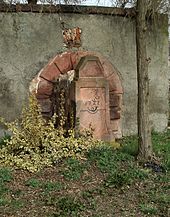Großbardau
Großbardau has been the second largest village district of Grimma since 2006 and is located on the eponymous Parthe river .
history
The river name Parthe is partly Germanic, partly Slavic ("stinking", but here in its upper reaches it is very clean, the existence of crabs proves that). On the terminal moraine at Schnellbach , northwest of Großbardau, the remains of a Slavic settlement were found during the opening of a sand pit. In the Middle Ages, the Bornaische Strasse leading in this direction was also called Windgasse, which indicates Wendish = Sorbian settlement.
Around the turn of the millennium, German colonization of the region gradually began. Due to its favorable location at a ford through the then marshy Parthen floodplain, Großbardau was an important " escort " station on the Old Salt Road throughout the early Middle Ages . This historical trade route connected the then German settlement area Leipzig-Magdeburg with the low-salt Bohemia. In the beginning, Großbardau was the last German base before crossing the large Erzgebirge jungle, in which there was a scattered Slavic settlement only along the often impassable mountain valleys.
Historians suspect the construction of a wooden church by 1160 at the latest. The village and church "Parde" (Großbardau) must have existed long before they were first mentioned in documents in 1218. After all, this first mention was about the right of the Saxon margrave Dietrich the distressed to run a chapel (small church) outside the Bardauer parish in his Grimma castle. In the same year Grimma received market rights . The large Frauenkirche was built in this then rapidly growing market town in 1220, thus ending the time of Großbardau as a regional center and only Kleinbardau, Bernbruch, Otterwisch, Grethen and Hohnstädt belonged to the Großbardau parish.
In the "Gilsenburg" on the corner of Parthenstr./Alte Schulstr. was once the escort house for the Salzstrasse . Together with the cemetery and the well-fortified church, this complex is located on a hill, which is largely surrounded by a two to five meter high wall-topped rock edge. Here in the old town center you can also find the names "Badergasse" and "Schmiedeteich", in 1308 a "Conradus Sutor de Parda" (Konrad the shoemaker from Bardau) is mentioned in a document, which was atypical for rural settlements at the time and leaves them rather Suppose planning a small town.
Margrave Heinrich the Illustrious donated the village "Maior Parda" to the hospital in Grimma in 1241, and in 1251 both were taken over by the Cistercian monastery that had moved from Torgau to Grimma / Nimbschen . The farmers and the two water mills had to deliver their taxes there, the abbess ruled and abandoned land automatically fell to the monastery.
In 1355 there was a spectacular court case in which the abbess approved of the Großbardauer farmers in their demand for cheaper milling fees. It was beneficial that the power of the monastery did not make peasants serf here, but disputes between the feudal lords and the monastery dragged on for centuries. More than 200 years later, the grand bartenders had to have their old right confirmed at a high Saxon court that they did not have to send their children to serf services. Even today you can see that there is only a very simple manor and no castle in the village , but there are many very large farms.
Incorporations
The community Großbardau with the districts Großbardau (approx. 1000 Ew.) And Waldbardau (approx. 150 Ew.) Belonged since July 1, 1972 Kleinbardau (approx. 350 Ew.) And since January 1, 1974 also Bernbruch (approx. 250 Ew.). After a few years of administrative partnership, it was incorporated into Grimma on January 1, 2006.
Soccer
SV Großbardau is currently playing in the 2nd district class B Muldental. The club was re-founded in 2009, as it had previously been on a break of several years. The SV Großbardau stadium is called "Pappelstadion" and is located on Großbothener Straße. The sports field has a grass field as well as cabins and a sports home.
Attractions
The list of cultural monuments in Großbardau includes the cultural monuments of the place.
Sons and daughters of Großbardau
- Carl Christoph Traugott Tauchnitz (1761–1836), pioneer of stereotype (inexpensive mass printing of books)
- Berndt Keller (* 1946), German sociologist and administrative scientist
- Oskar Karich (1895–1959) master cooper and local writer
literature
- Horst Naumann : 750 years of Großbardau - a festival offering. Council of the community, Großbardau 1968, 87 pages
- Cornelius Gurlitt : Grossbardau. In: Descriptive representation of the older architectural and art monuments of the Kingdom of Saxony. 19. Issue: Amtshauptmannschaft Grimma (1st half) . CC Meinhold, Dresden 1897, p. 122.
Web links
- Großbardau in the Digital Historical Directory of Saxony
Individual evidence
Coordinates: 51 ° 12 ′ 17 ″ N , 12 ° 41 ′ 51 ″ E








